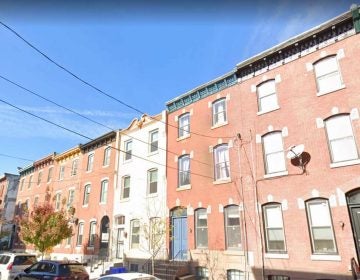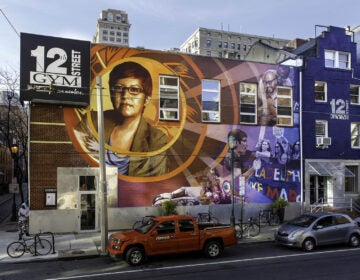Committee supports historic designation for Germantown Boys and Girls Club, West Philadelphia Title & Trust

The Committee on Historic Designation is one of the lower hurdles a nomination to the historic register must cross. The body is stocked with historians, an archaeologist, and a planner who are empowered to recommend such nominations to the larger Historical Commission. The committee’s purview is limited to a set of criteria that determines eligibility for designation. When the full Historical Commission considers a nomination, it may choose to accept the committee’s recommendation and weigh in other factors (which are unlimited and undescribed).
At this month’s meeting, all of the six buildings under consideration got the support of the committee on historic designation. Despite this consensus, the meeting still opened with a bang as the controversy surrounding the Germantown Boys and Girls Club made its debut at 1515 Arch Street.
23 W PENN ST: Germantown Boys and Girls Club
The Philadelphia Boys and Girl Club’s plan to raze, then supersize it’s Germantown location is not winning the universal acclaim its architects hoped for. The proposal would level the existing structure—which is over a century old—and replace it with a vast hockey rink and a state-of-the-art facility.
Opponents of the current plan like the idea of a souped-up Boys and Girls Club, just not at this location. They object that the site isn’t ideal for an institution of this magnitude and that such a hearty investment would have a bigger impact in one of Germantown’s more impoverished sections. They also objected the demolition of the current Boys and Girls Club building, which they view as a community icon.
Hence the nomination from the Penn Knox Neighborhood Association and Oscar Beisert.
Historical Commission Executive Director Jon Farnham opened the session by declaring that he found the nomination lacking. He said that the staff did not support its recommendation to the larger historical commission.
The Boys and Girls Club’s lawyers gladly expanded upon this line of reasoning as did architectural historian George Thomas who was hired deconstruct the preservationists’ arguments.
In an earlier interview with PlanPhilly, Thomas strongly implied that the opposition to the Boys and Girls Club was racially motivated. At this designation committee hearing, he doubled down on that claim, describing a larger narrative in which the Boys and Girls Club plays a key role in “the racist history that made Germantown one of the preeminent Jim Crow sites in Philadelphia.”
Thomas went on to describe the club’s place in segregated Germantown, noting that the nearby Wissahickon Boys and Girls Club had initially been created to serve African-American students denied entry to the location on Penn Street. Additionally, Thomas insisted that the building itself is without merit.
“The building is of modest interest, the architect is of modest interest,” said Thomas. “More crucially, the building and nomination are caught in battles…that are part of the culture that’s created two Germantowns.”
Thomas’ testimony engendered strong reactions from the audience and the committee itself.
“I’d like to address the elephant in the room,” said Aaron Wunsch, an assistant professor of historic preservation at the University of Pennsylvania. “Which is that rather than doing their homework on this or engaging with the neighbors, the people resisting this nomination have engaged in something much easier: race baiting.”
The committee rendered its judgment in a more temperate fashion, agreeing with Farnham that the nomination was flawed because it could have used more research beyond the early 20th century. But it also felt the broader case for preservation was strong and voted unanimously to recommend it to the larger historical commission.
“There are a lot of arguments presented here that I would like to rebut in detail,” said Jeffrey Cohen, an architectural historian at Bryn Mawr College who sits on the committee. “But Dr. Thomas’ report also points out a lot of 20th century history of the place, even if it is the negative history of this place, that is key to the story of Germantown.”
The rest of the agenda proved far less contentious.
7345 AND 7347 OXFORD AVE: Horace Castor House
Next up, the Horace Castor House in Burholme, the work, and once the home, of noted Philadelphia architect Horace Castor. (His family’s prominence can still be seen on one of the lower Northeast’s more vibrant commercial corridors.)*
Constructed in the late 19th century, the magnificent building used to have many genteel neighbors. But today it is one of the only edifices remaining from the neighborhood’s tonier days, when it offered shelter to local elites seeking escape from cramped Center City and older rowhouse stock.
“I want to commend the staff on one of the best nominations I’ve read in quite some time,” said Paul Steinke, head of the Preservation Alliance of Greater Philadelphia. “I grew up around the corner from here. I’m glad to see these houses finally getting recognition.”
One of Castor’s descendants, Richard Castor, spoke up in support of preserving his family’s legacy. Farnham noted that the current owner opposes the nomination, but that didn’t prevent the committee from recommending it to the larger commission.
3500-10 LANCASTER AVE: West Philadelphia Friends Meeting House
The West Philadelphia Friends Meeting House and School is being nominated by the University City Historical Society because of its relevance as a relic of the Quaker influence in the region.
The meeting house once housed a Hicksite congregation, in contrast with the religion’s orthodox strain which was housed further up Lancaster Avenue.
The building is located in a part of the neighborhood that is seeing a lot of development activity spilling over from Drexel and the University of Pennsylvania’s waxing fortunes. Immediately to the left of the meeting house is a 28-story tower constructed two years ago, and the nominators said that the zoning of the parcel would support demolition if it changed hands.
Although the meeting house’s owners reportedly expressed concerns about the nomination, the University City Historical Society met with them and believed their concerns had been allayed.
The committee voted to recommend its addition to the local register.
1006-08 W LEHIGH AVE: Excelsior Trust Co
The Excelsior Trust Company building in North Philadelphia was designed by Horace Trumbauer, architect of the Philadelphia Museum of Art and the Free Library of Philadelphia. The building is designed in a similar Beaux-Arts Classic style, easily distinguishing it from its surroundings on the faded commercial strip.
The committee members nitpicked the nomination of preservation advocate H.R. Haas, saying that he described the neighborhood as far more fashionable than it actually had been in the early 20th century. At that point, they attested, the upper middle classes were already fleeing North Philadelphia for Elkins Park and similar locales.
But Haas defended his nomination ably, despite this being the first he had ever presented to the body. The architecture on this corridor stands out among the city’s other neighborhood hubs of yore.
“If you look at Germantown and Chelten, or Kensington and Allegheny I would say that the quality and scale of the buildings on this avenue are both larger and richer than at either of those intersections,” said Haas.
The committee then recommended adding it to the register.
862-72 N 41ST ST: Rorke Mansion
Haas’s other nomination, of the Rorke Mansion in West Philadelphia, went a little less smoothly. The elegant old mansion is in worse state than what can be seen from the street (or from Google Earth and Google Street). There is a large hole in the roof, which will make saving the building a challenge.
Despite its decrepit context, Haas’ nomination received a round of praise. His description of the detached Victorian mansion makes an unusually enjoyable read. (“Less than a year after the beginning of construction, Allen B. Rorke was dead and his family members would soon lose their social status, wealth, and sanity.”)
“I want to attest that this is really a neighborhood landmark,” said Kathy Dowdell, a West Philadelphia resident and longtime preservation advocate. “It’s a captivating building. Even it in its current condition, it gives a really good sense of what that neighborhood was at one time.”
The committee voted to recommend adding it to the register.
600-08 N 40TH ST: West Philadelphia Title & Trust Co
The West Philadelphia Title & Trust Company is being nominated by the Philadelphia Historical Commission’s own staff. The building defines the intersection where 40th Street meets Lancaster and Haverford avenues, mixing the grandeur of West Philadelphia’s history with its current working class reality: the stately building now houses Hoagie City.
The University of Pennsylvania’s Wunsch gladly supported the nomination and noted that he didn’t believe it to be on the national historic register. In that case, the Historical Commission staff’s expertly written nomination could be adapted to add it to national register. Although no protections come with such an honor, it would allow the owner of the building to apply for historic tax credits to help preserve the building.
“I want to command the commission for beginning to go into the neighborhoods and finding things that really are landmarks,” said Dowdell.
The building’s owner, Sam Kim Chen, attended the meeting and said that he was confused by the proceedings. The committee advised the staff to conference with him after the meeting, voted to recommend the building, and recessed for the day.
*Note: An earlier version of this article mistakenly stated that the Horace Castor house is in the Fox Chase neighborhood. It is in Burholme. PlanPhilly regrets the error.
WHYY is your source for fact-based, in-depth journalism and information. As a nonprofit organization, we rely on financial support from readers like you. Please give today.







